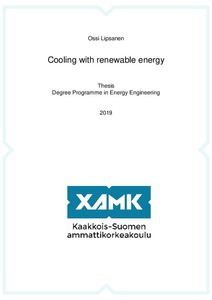Cooling with renewable energy
Lipsanen, Ossi (2019)
Lipsanen, Ossi
2019
All rights reserved. This publication is copyrighted. You may download, display and print it for Your own personal use. Commercial use is prohibited.
Julkaisun pysyvä osoite on
https://urn.fi/URN:NBN:fi:amk-2019112823294
https://urn.fi/URN:NBN:fi:amk-2019112823294
Tiivistelmä
This thesis is a part of the Southeast Finland University’s RDI project which aims at studying and developing methods for cooling real estates, industrial processes and premises. The goal of the project was to adapt the rising temperatures due to climate change and to cover the growing need for cooling through renewable energy. The focus of this thesis is on the implementation of cooling with renewable energy. Its implementation becomes increasingly necessary as climate change advances.
As a result of the thesis, a summary was produced about the use of renewable energy in cooling and the ways in which they can be combined. Firstly, the most commonly used techniques for cooling are considered, as the use of existing technology is a quicker and more affordable solution to fight against climate change than the development of a completely new, yet more effective, technology. Secondly, the task is to analyse the alternatives for the implementation of electric cooling with suitable forms of renewable energy and possible solutions to emerging challenges. Thirdly, the implementation of heat cooling is evaluated in a similar way. Finally, the facilities using renewable energy in cooling are examined and the suitability of the solutions for conditions in Finland is analysed. Solutions to construction engineering and environmental design are excluded.
The thesis resulted in a review using renewable energy in cooling and the ways in which they can be combined. The results were combined to charts, which show the acquired benefits and possible challenges. Existing ways of cooling are highly sophisticated and applicable to many uses. Renewable energy is also eliminating its old weaknesses, such as its high price. The most significant challenges are in the energy efficiency and in the improvement of renewable energy availability based on demand. To obtain the best results, a combination of cooling and energy sources appropriate to each situation are recommended. The hybrid alternatives could be considered where they are appropriate.
As a result of the thesis, a summary was produced about the use of renewable energy in cooling and the ways in which they can be combined. Firstly, the most commonly used techniques for cooling are considered, as the use of existing technology is a quicker and more affordable solution to fight against climate change than the development of a completely new, yet more effective, technology. Secondly, the task is to analyse the alternatives for the implementation of electric cooling with suitable forms of renewable energy and possible solutions to emerging challenges. Thirdly, the implementation of heat cooling is evaluated in a similar way. Finally, the facilities using renewable energy in cooling are examined and the suitability of the solutions for conditions in Finland is analysed. Solutions to construction engineering and environmental design are excluded.
The thesis resulted in a review using renewable energy in cooling and the ways in which they can be combined. The results were combined to charts, which show the acquired benefits and possible challenges. Existing ways of cooling are highly sophisticated and applicable to many uses. Renewable energy is also eliminating its old weaknesses, such as its high price. The most significant challenges are in the energy efficiency and in the improvement of renewable energy availability based on demand. To obtain the best results, a combination of cooling and energy sources appropriate to each situation are recommended. The hybrid alternatives could be considered where they are appropriate.
